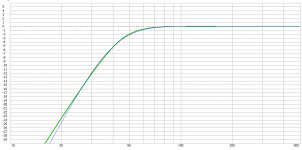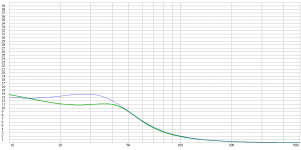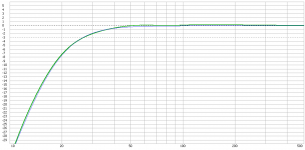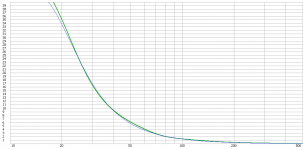Let’s throw a DSP in the mix and we EQ all the responses the same.. �� gone are the group delay differences. Then compare the decay graphs again.
Also, you should probably not compare the same driver in either configuration. You’re not racing a rally with a F1 car either.
Also, you should probably not compare the same driver in either configuration. You’re not racing a rally with a F1 car either.
Nogone are the group delay differences.
The graphs would be different but not the same. Strongest tendencies would show through.Then compare the decay graphs again.
Isn't group delay a function of frequency response?
See the two graphs here, one vented (green), one closed (blue). It's really hard to get them exactly close, but I think it's quite good. The closed one has a LT to extend the response, and an additional high pass to match it up. Very much as you would actually do for a closed box sub. Next check the group delay. It's also not perfect, but very close. If you look at the frequency response, you can see that the area's where it differs are actually exactly there.
For reference, this is a RCF LF18X401. 98L vented @39Hz, vs 61L closed. Obviously, when you look at maxSPL >30 Hz the vented system wins, however at 20Hz the closed system as 10dB more headroom.
You can change that of course by lowering the tuning frequency. Let's say to 20Hz. This will skew the response, but will give you about 6dB more headroom vs closed at 20Hz. If you "only" need 110dB/1m at 20Hz, you can EQ it flat just fine and use it at full power
Let's do the exercise and see if we can align the two boxes at this config. Graphs attached.. Group delay is virtually identical.
Attachments
Boiling this down to practical implementations, you are in the room mode part of the frequency response. Are you using EQ?
If yes, you can change the group delay, Q and roll off slope of your woofer system. This changes the transient response, see Linkwitz for details. Ported may gain you less EQ requirements but if looking strictly at roll off and group delay this seems a moot point when using EQ no matter horn, vented, sealed or TL, MLTL ect.
opps, didn't read the last 2 posts........says the same thing sorry.
If no, you can dial in the response based on room performance so all this theory may only be good for predicting max SPL anyways as it will change depending on room.
I agree with Mark100 regarding phase linear stuff. I have trouble hearing a difference nevermind a marked improvement. But I may have rubbish ears so thats ok!
If yes, you can change the group delay, Q and roll off slope of your woofer system. This changes the transient response, see Linkwitz for details. Ported may gain you less EQ requirements but if looking strictly at roll off and group delay this seems a moot point when using EQ no matter horn, vented, sealed or TL, MLTL ect.
opps, didn't read the last 2 posts........says the same thing sorry.
If no, you can dial in the response based on room performance so all this theory may only be good for predicting max SPL anyways as it will change depending on room.
I agree with Mark100 regarding phase linear stuff. I have trouble hearing a difference nevermind a marked improvement. But I may have rubbish ears so thats ok!
Last edited:
And finally, there's no point in building a true "subwoofer horn" unless it's as big as a walk-in closet or, better yet, your garage
Agreed about the horn subwoofers.
I actually saw subwoofers with cabinets as big as walk in closets. It was in a high end home in a high end Chicago North Shore suburb. The room was on the first floor and was around 35 x 60 feet with around 18 foot ceilings. There were satellite speakers mounted on the walls around 9 feet off the floor. The satellite speakers were around 1 cubic foot so I knew there were some subwoofers. They were in the basement and the bass came through the floor through what appeared to be heat vents. I asked and the owner showed me a couple rooms in the basement with subwoofers that had like 6-8 cubic foot enclosures.
a what? Low shelf? Just tell us what the filter settings are.The closed one has a LT
So I also had this thought. The pressure at tuning is really high and compliance is high, as well. High compliance + High pressure = Slop Fest. Well how bad is it camplo? Just go look at the decay results for any undampened vented design in comparison to closed box. The closer to the tuning note of a vented, one plays, the more of this poorly controlled woofer experience is imparted on the signal. Which is exactly why you should tune an octave lower than desired cutoff, which is the same method used for horns, which also exhibit the same behaviors changes, near cutoff, cutoff not being theoretical but a physical and measurable aspect of all vented designs.
Tuning to woofer Fs is putting two resonances on top of each other. The woofer has the highest Q at woofer fs. The box has the highest Q at fundamental, which for vented is the tuning note. Model resonance is an area of higher Q.
Regardless how it appears in the numbers, you cannot use the minimum phase relationship to manipulate mechanically derived positions such driver and box compliance, using frequency. So, even though this minimum phase relationship results in a group delay matching the higher compliance system, the initially lower compliance system will sound better. The appearance of high pressure, in the form of high group delay derived from a filter, will be a false reading for the sealed, That pressure will not be there and electronic induced group delay will not take away the advantages of that. But now I'd have to argue, can we hear this....and I don;t know lol.
Tuning to woofer Fs is putting two resonances on top of each other. The woofer has the highest Q at woofer fs. The box has the highest Q at fundamental, which for vented is the tuning note. Model resonance is an area of higher Q.
Regardless how it appears in the numbers, you cannot use the minimum phase relationship to manipulate mechanically derived positions such driver and box compliance, using frequency. So, even though this minimum phase relationship results in a group delay matching the higher compliance system, the initially lower compliance system will sound better. The appearance of high pressure, in the form of high group delay derived from a filter, will be a false reading for the sealed, That pressure will not be there and electronic induced group delay will not take away the advantages of that. But now I'd have to argue, can we hear this....and I don;t know lol.
You should measure 2 subs with the exact same anechoic room frequency response, meaning you should at least add a 2 pole highpass filter to the sealed sub. Then compare the "in room" RT60 at 10-100Hz.
Btw an in room RT60 at 50Hz that is 0.5 sec, is exceptional good.
What was the RT60 of the worst simulation posted here?
Btw an in room RT60 at 50Hz that is 0.5 sec, is exceptional good.
What was the RT60 of the worst simulation posted here?
LT means Linkwitz transform, a low shelf with a notch, helps change the rolloff Q to a different value. The values are not really important he's trying to show that the time and frequency responses are linked. Make a sealed roll off like a vented and the group delay ends up being very similar.a what? Low shelf? Just tell us what the filter settings are.
I do that on my line array, extend the low end and roll it off at 24dB per octave. Sealed box with a response like a vented but no over excursion below tuning and without the extra boost in efficiency from the port.
LT means Linkwitz transform, a low shelf with a notch, helps change the rolloff Q to a different value. The values are not really important he's trying to show that the time and frequency responses are linked. Make a sealed roll off like a vented and the group delay ends up being very similar.
Exactly.. it doesn't really matter what kind of fancy filtering is used (in the IIR domain at least). Group delay and Frequency response are directly coupled. Woofer system A (woofer, box + EQ) having the same response as woofer system B will also have the same group delay. I'm betting the decay will be pretty much the same af well.
Close but no cigar?Sealed box with a response like a vented but no over excursion below tuning and without the extra boost in efficiency from the port.
Hell no.I'm betting the decay will be pretty much the same af well.
Obviously there still remains a difference between sealed and vented. So your argument is nullWhat was the RT60 of the worst simulation posted here?
I've heard the blind test theory. I also found a trend for mastering engineers to prefer sealed cabs describing vented to be slow and less resolution. I also see the evidence in the spectrogram and decay readings, and the impedance readings and my understanding of compliance....Whats the RT60 standard for a mastering room?
This has full blown turned into a sealed versus vented argument if only because the differences in the two exaggerate the difference between tuning like I suggest, vs having cutoff within the passband.
The only difference is that I have found a group of professionals who claim to hear the difference...Either Mastering engineers have better ears (what are the chances of that), or the other crowds rooms are so bad (what are the chances of that), they can't hear how bad their speakers are or aren't....or both.
Heres a quote from a Mastering Studio designer
The optimal value varies with the room (volume, etc) - there's no particular recipe. The .4/.2 is a good benchmark though.
You should make sure the reverb is as diffused as it can be and that the decay is linear and homogenous (as little variations as possible between octaves).
Oh wow "decay is linear and homogenous (as little variations as possible between octaves)" Oh really, big surprise there lol. An even spectral Decay? So should I put the resonant peak (huge increase in spectral decay centered around one area) of my driver/enclosure in the middle of my passband anyway oooorrrrrrr.........
Last edited:
Yes, one can equalize sealed and vented so their frequency responses are identical. And this seems to imply their phase responses would also be identical. But this isn't true because vented box isn't minimum phase - there are two sources of the sound it produces.
To my mind, the proper way to tune a vented design for SQ is to seal up the vent and use it sealed. Vented is an attempt to trade off some characteristics negatively correlated with SQ for more SPL and less excursion around the the box tune frequency. Those characteristics include the resonance itself, the pipe resonance of the vent, the higher group delay of the vented design, the group delay of the high pass filter that the vented box alone requires, the high latency of the FIR filter optionally used to flatten the group delay. I'm sure one can work around these things and overcome them to some extent and/or argue that they don't matter for one reason or another but the very fact that you are discussing vented to begin with means that SQ isn't your highest priority.
On the other hand, if you push the SQ too hard at the low end, SQ will suffer. So to make up the 6 db or so advantage vented has at resonance, stuff a second driver in the vented box whose vent you just sealed. And then equalize it for the frequency that you desire. Since a vented box typically is much larger than a sealed needs to be, there should be room for it.
To my mind, the proper way to tune a vented design for SQ is to seal up the vent and use it sealed. Vented is an attempt to trade off some characteristics negatively correlated with SQ for more SPL and less excursion around the the box tune frequency. Those characteristics include the resonance itself, the pipe resonance of the vent, the higher group delay of the vented design, the group delay of the high pass filter that the vented box alone requires, the high latency of the FIR filter optionally used to flatten the group delay. I'm sure one can work around these things and overcome them to some extent and/or argue that they don't matter for one reason or another but the very fact that you are discussing vented to begin with means that SQ isn't your highest priority.
On the other hand, if you push the SQ too hard at the low end, SQ will suffer. So to make up the 6 db or so advantage vented has at resonance, stuff a second driver in the vented box whose vent you just sealed. And then equalize it for the frequency that you desire. Since a vented box typically is much larger than a sealed needs to be, there should be room for it.
Obviously there still remains a difference between sealed and vented. So your argument is null
But what it way way more dominant?
Answer: the room.
RT60 at 50Hz of 0.5 is considered extremely good. A factor 5x the worst in your simulation.I've heard the blind test theory. I also found a trend for mastering engineers to prefer sealed cabs describing vented to be slow and less resolution. I also see the evidence in the spectrogram and decay readings, and the impedance readings and my understanding of compliance....Whats the RT60 standard for a mastering room?
Or your listening test did not meet the scientific criteria. Iow not blind, not matched anechoic frequency response, etc...The only difference is that I have found a group of professionals who claim to hear the difference...Either Mastering engineers have better ears (what are the chances of that), or the other crowds rooms are so bad (what are the chances of that), they can't hear how bad their speakers are or aren't....or both.
We don't hear with our eyes.Heres a quote from a Mastering Studio designer
Oh wow "decay is linear and homogenous (as little variations as possible between octaves)" Oh really, big surprise there lol. An even spectral Decay? So should I put the resonant peak (huge increase in spectral decay centered around one area) of my driver/enclosure in the middle of my passband anyway oooorrrrrrr.........
ears lie, measurements don't.We don't hear with our eyes.
I listen in the nearfield so direct field energy rules, the room doesn't produce sound, the speaker does, thus it is dominate at all frequencies. Don't believe me, unplug the speakers and take some measurements. The room is a factor but some of these aspects are merely compounded by the room. If the room adds X amount of decay/group delay 1X is still less than 2X....The speakers signal is still reaching you before reflections and is more influential than the rooms energy.But what it way way more dominant?
- I understand scientific method. I also respect the professionals responsible for every piece of recorded music today. Even though they can be as random as mix engineers and hobby loudspeaker designers at times, the most of them are pretty on point. When you are actually responsible for the signal being sold, vs just a listener....it must raise the stakes a lot.your listening test did not meet the scientific criteria
Last edited:
I never called anyone lame. I am a mastering engineer so my goals aren't the same as the average listener. Its more important for me, or anyone interested in accurate playback.
Accurate playback vs Still sounds good to meee....lol
Also, I don't have to preach to Mastering Engineers, they've seem to have chose sealed/infinite baffle as king from what I gathered but they also still feel like design takes precedence over enclosure...and that they've encountered some bad vented designs. I can't say I speak as the authority but I feel strongly there may be benefit for all with this knowledge. I have to remind myself that most people could careless and just want the bass to go boom.
Accurate playback vs Still sounds good to meee....lol
Also, I don't have to preach to Mastering Engineers, they've seem to have chose sealed/infinite baffle as king from what I gathered but they also still feel like design takes precedence over enclosure...and that they've encountered some bad vented designs. I can't say I speak as the authority but I feel strongly there may be benefit for all with this knowledge. I have to remind myself that most people could careless and just want the bass to go boom.
Last edited:
- Status
- This old topic is closed. If you want to reopen this topic, contact a moderator using the "Report Post" button.
- Home
- Loudspeakers
- Multi-Way
- The proper way to tune a vented design for SQ.



